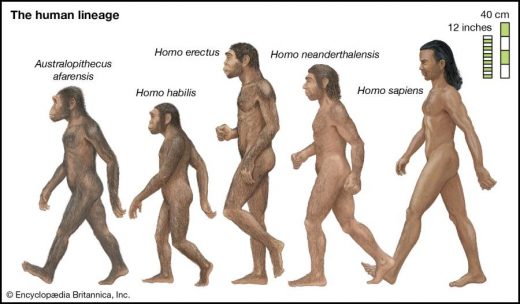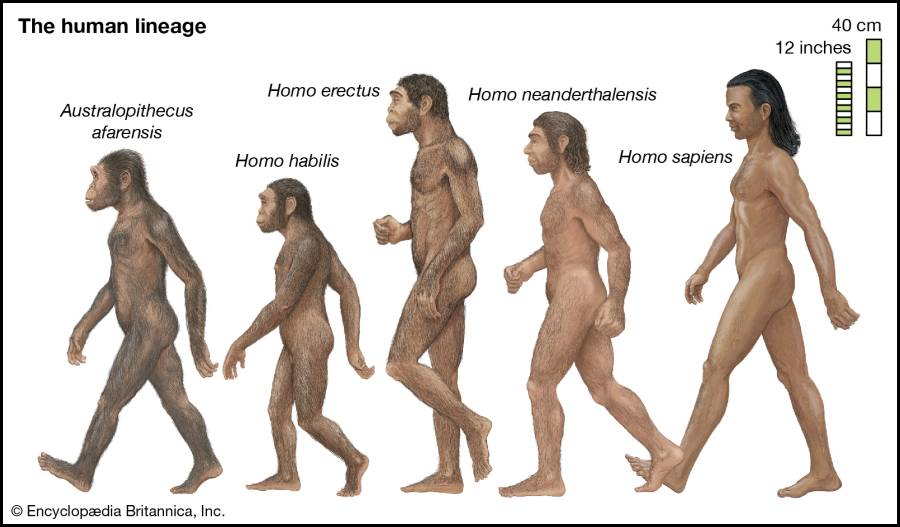The evolution of human began about 65 million years ago with the emergence of a group called primates, descended from the class of mammals, belonging to the vertebrate branch of the animal kingdom. This team has evolved over millions of years into different families, genera and species like branches of a tree. The last time a single female primate had two daughters was about 6 million years ago. One of them became the ancestor of all chimpanzees, while the other became our grandmother.
Our ways separated.
Contrary to popular belief, the word human does not only represent modern humans, namely “Homo sapiens”. Even 100,000 years ago, Earth was home to at least six different human species. But we are the only representative of the human species left today.
We are in East Africa. We witness very familiar human characters: worried mothers hugging their children, children playing in the mud, the elderly who want to be left alone, and young people who rebel against the rules of society. These archaic people fell in love, played, formed close friendships, and struggled for power and status. But chimpanzees, baboons and elephants did it too. People had no special status at all. No one had the slightest idea that one day their descendants would walk on the moon, split the atom, decipher the genetic code, and write history books. Prehistoric humans were ordinary animals, influencing their surroundings no more than gorillas, fireflies, or jellyfish.
So what happened? What happened that the only species that managed to survive among humans, “Sapiens”, became the master of the worlds? We will talk about this in the following pages. Let’s take a closer look at the evolutionary story of the human species.
Human evolution story
Humans first evolved from a primate genus called Australopithecus 2.5 million years ago in East Africa. About 2 million years ago, some of these archaic men and women left their homeland and migrated to various parts of North Africa, Europe, and Asia. Human societies evolved in different directions, as survival in the snowy forests of northern Europe required different characteristics than in the humid jungles of Indonesia. As a result, many different species emerged; scientists gave each of them a distinctive Latin name.
Homo Species
Humans in Europe and Western Asia evolved into Homo neandertalensis, often referred to as “Neanderthals.” Neanderthals were stronger, more muscular than Sapiens and were attuned to the Western Eurasia of the Ice Age. More eastern parts of Asia were inhabited by Homo erectus, meaning “upright man.” This species has set a record surviving in this region for close to two million years.
On the island of Java in Indonesia lived Homo soloensis, meaning “Man of the Solo Valley”. This species was adapted to tropical life. On another Indonesian island, Flores, archaic humans underwent a dwarfism process. People first came to Flores when the sea level was extraordinarily low; meanwhile, the island was easily accessible from the mainland. When the seas rose again, some people were stranded on very scarce islands.
The larger humans, who needed more food, died first, the smaller ones survived much better, and the Flores humans became dwarfs for generations. Known as Homo floresiensis by scientists, this unique species could only reach one meter in length and weighed no more than 25 kilograms. In turn, they could make stone tools and even hunt dwarf elephants on the island from time to time.
In 2010, another missing sibling was rescued from nothingness when scientists discovered a fossilized finger bone while excavating Denisova cave in Siberia. Genetic analysis proved that the finger belonged to a previously unknown human species, which was named Homo denisova. Who knows how many more of our lost relatives are waiting to be discovered in other caves, islands and different climates.
Evolution in East Africa
As these humans evolved in Europe and Asia. Evolution in East Africa did not stop either. The cradle of humanity continued to be home to many species, such as Homo rudolfensis, meaning “Rudolf Lake Man”, Homo ergaster, “Hard-working Man,” and Homo sapiens, our species, which we humbly call “Intelligent Man.”
Some members of these species were giants, while others were dwarfs. Some were fearsome hunters, while others were harmless plant gatherers. While some lived on a single island, many crossed continents. But they all belonged to the genus Homo. They were all human.
Let’s clarify an opinion that is misunderstood by most people here. All these human species did not follow a straight line of ancestry, one successor to the other. So not all previous species are our old models. In fact, from about 2 million years ago to 40,000 years ago, the earth was home to many human species at the same time.
Evidence of human evolution
Everything is ok so far, but how do we know this whole story as if we lived in those ages? Of course, some pieces of the story are missing, but every piece of this puzzle that fits into place is based on fossils discovered by anthropologists, radiometric dating and gene analysis done on these fossils.
First, a researcher named Morris Goodman compared the proteins of gorilla, chimpanzee, orangutan and human using immunological methods in 1963 and proved that the primates closest to humans are the African large primates gorilla and chimpanzee.
A lot has changed since then, and today we make use of DNA polymorphism as we trace back the origin and evolution of human beings. For example, we know very well today that the degree of genetic variation between chimpanzees and humans is surprisingly small. Chimpanzee and human genomes are 98.77% identical.
Next Page; The chronological evolutionary process of the human species.
Views: 263








